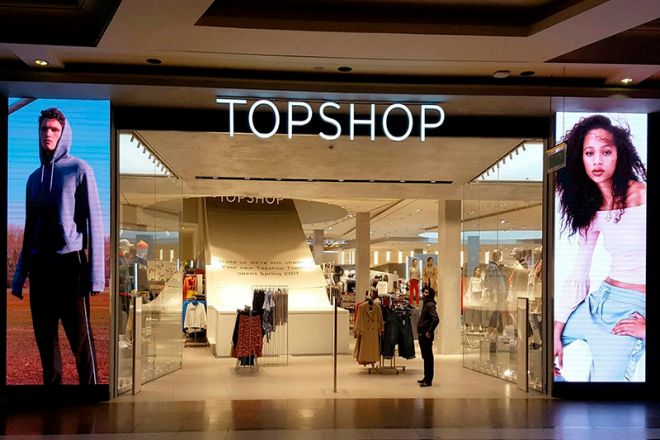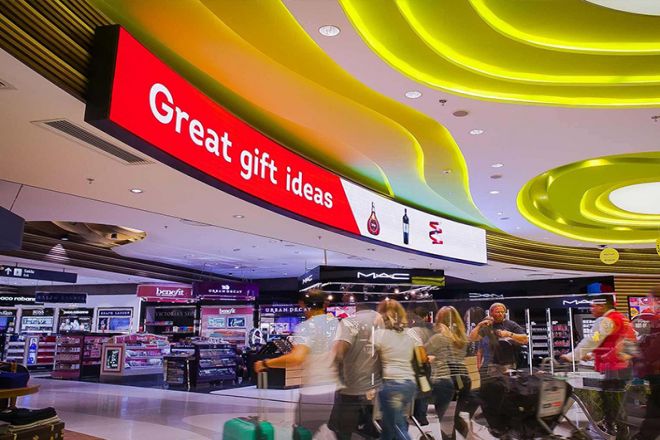介绍

With the rapid development of digital technology, the advertising industry has also ushered in unprecedented changes. In this change, LED显示屏, with their unique advantages, play an increasingly important role in digital point-of-sale advertising.
With its high brightness, high definition, high color saturation, and other characteristics, LED displays provide advertisers with more vivid and realistic display effects, effectively attract consumers’ attention, and improve the communication effect and commercial value of advertising.
1. What is digital point-of-sale advertising?
Digital point-of-sale advertising (DPOSA) refers to advertising and promotion activities carried out at points of sale (such as stores, retail stores, catering places, etc.) using digital technology.
This form of advertising combines the concepts and technologies of modern digital marketing and displays products, services, or brand information to consumers through digital media such as electronic displays, touch screens, and interactive devices, thereby achieving effective interaction with consumers and promotion purposes.
The following are the main features of digital point-of-sale advertising:
Digital media: Digital point-of-sale advertising mainly relies on digital media such as electronic displays and touch screens for display. These media have the characteristics of high definition and high color reproduction and can present vivid and realistic advertising effects.
实时更新: Through digital technology, advertising content can be updated in real-time, and advertising strategies can be adjusted at any time to adapt to market changes and consumer needs. This flexibility makes digital point-of-sale advertising more targeted and timely.
互动性: Digital point-of-sale advertising usually has interactive functions. Consumers can interact with advertisements by touching and scanning QR codes to obtain more product information, coupons, etc., which increases consumers’ sense of participation and willingness to buy.
精准定位: With the help of technologies such as big data and artificial intelligence, digital point-of-sale advertising can achieve accurate positioning, push personalized advertising content according to consumers’ shopping habits, preferences, and other information, and improve the conversion rate and effect of advertising.
数据分析: Digital point-of-sale advertising can collect and analyze data such as advertising display, interaction, and conversion to help advertisers understand advertising effects, optimize advertising strategies, and improve the ROI (return on investment) of advertising.
2. What are the advantages of LED displays over other digital point-of-sale advertising?

The advantages of LED displays in digital point-of-sale advertising are mainly reflected in the following aspects:
- 高清晰度、色彩鲜艳:
LED displays can provide high-resolution and bright color effects, making advertising content more vivid and attractive. This advantage ensures the clear communication of advertising information, allowing consumers to accurately capture the characteristics of the product and the image of the brand.
Compared with traditional digital point-of-sale advertising media, LED displays have more advantages in color reproduction and detail display and can present more realistic and lifelike images and video information.
- Sufficient brightness and contrast:
LED displays have high brightness and contrast and can maintain display effects even in bright outdoor environments. This makes LED displays an ideal choice for outdoor advertising, attracting more attention and ensuring that advertising information is still clearly visible in complex environments.
- Customizability and flexibility:
LED displays can be customized according to different needs, including size, shape, and installation methods. This flexibility allows LED displays to adapt to various scenarios, such as indoor displays, outdoor billboards, shopping mall advertisements, etc., to meet the needs of different places.
Merchants can customize unique LED displays according to their own brand image and marketing strategies, thereby enhancing brand recognition and advertising effectiveness.
- Environmental protection, energy saving, and long life:
LED displays use a new power control technology, which is more energy-saving than traditional advertising, reduces energy consumption, and reduces environmental pollution. This environmental protection and energy-saving feature makes LED displays more economical and socially valuable for long-term use.
At the same time, the service life of LED display screens can generally reach more than 10 years, reducing the cost of replacement and maintenance and further improving advertising efficiency.
- Fast update and real-time:
LED display screens support remote control and real-time content updates and can quickly replace advertising content without manual operation. This enables merchants to adjust advertising content in a timely manner according to market changes and promotion strategies to ensure the timeliness and pertinence of information.
- Interactivity and sense of participation:
Modern LED display screens support touch screens and interactive functions. Consumers can interact with advertisements by touching the screen to obtain more product information, coupons, etc. This interactivity not only increases consumers’ sense of participation but also improves the conversion rate and effect of advertisements.
- Wide coverage and cost-effectiveness:
LED display screens are usually installed in commercial areas and transportation hubs with high traffic density, and can cover a wide range of audiences. At the same time, due to the relatively low maintenance cost and long service life of LED display screens, they are highly cost-effective.
3. The application of LED display screens in digital point-of-sale advertising is wide and diverse.
1). Retail stores and shopping centers
- Application examples:
In retail stores, LED display screens are used to display the latest product information, promotions, and brand images. They are usually installed at the store entrance, above the shelf, or near the cash register to attract customers’ attention.
In shopping malls, large LED screens are usually located above the central square or main channel to play the mall’s navigation information, brand advertising, event previews, etc.
- Function analysis:
The high brightness and high definition of LED screens can attract customers’ attention and enhance their interest in products and desire to buy.
Real-time updated advertising content can ensure that customers get the latest promotional information and increase their shopping satisfaction.
By playing brand image advertisements, LED screens help enhance brand memory and improve customers’ awareness and loyalty to the brand.
2). Catering and entertainment venues
- Application examples:
In restaurants, LED screens are used to display menus, special dishes, promotions, etc., to provide customers with intuitive ordering information.
In entertainment venues such as bars and KTVs, LED screens are usually used in locations such as stage backgrounds, box decorations, or corridor guides to create a unique atmosphere for the venue.
- 影响分析:
LED screens can intuitively display food information and improve customers’ ordering efficiency and satisfaction.
By playing music, videos and other content, LED screens can enhance the entertainment atmosphere of the venue and enhance customers’ experience.
Unique LED display screen decoration can enhance the grade and attractiveness of the venue and attract more customers.
3). Transportation hubs and outdoor advertising
- 应用:
In transportation hubs such as railway stations, airports, subway stations, etc., LED display screens are used to publish train and flight information, travel guides, and advertisements.
In outdoor billboards, building facades, and other locations, LED display screens are used to display brand image, product advertisements, and city publicity.
- 优势分析:
The high brightness and wide viewing angle characteristics of LED display screens enable them to remain clearly visible in outdoor environments, ensuring effective communication of information.
The real-time updated information release function enables transportation hubs to respond quickly to changes and improve travel efficiency and service quality.
Unique advertising creativity and visual effects can attract the attention of passers-by and enhance advertising effects and brand image.
4. Trends and challenges of future development of LED display screens

1). Technological innovation and upgrading
1.1). Display technology innovation:
High definition: As consumers’ requirements for picture quality increase, LED display screens will continue to pursue higher resolution and more delicate display effects.
Flexibility: The development of flexible LED display screen technology will make the display screen thinner, more flexible, and adaptable to more complex installation environments.
Transparency: Transparent LED display screens will achieve higher transparency and provide more possibilities for advertising creativity, especially in glass curtain walls, windows, and other occasions.
1.2). Intelligence and interactivity:
Intelligent management: Through the Internet of Things technology, LED display screens can realize functions such as remote monitoring, automatic diagnosis, and energy-saving management and improve management efficiency.
Enhanced interactivity: With the help of touch technology, face recognition, voice recognition, and other technologies, LED display screens will achieve richer interactive functions and enhance user experience.
1.3). The role of technological innovation:
Technological innovation will further enhance the display effect, stability, and interactivity of LED display screens, thereby enhancing its competitive advantage in digital point-of-sale advertising.
Technological innovation can also help companies expand new application scenarios and market space and increase market share.
2). Market competition and cost control
2.1). Market competition:
The LED display market is highly competitive, and many domestic and foreign companies have entered this field, resulting in frequent price wars.
With the continuous advancement of technology, new products continue to emerge, intensifying the intensity of market competition.
2.2). Cost control:
The rising prices of raw materials, manufacturing costs, labor costs, etc. have brought pressure on cost control to LED display companies.
The fierce market competition also requires companies to continuously reduce costs and improve product cost performance.
2.3). Maintaining competitive advantage:
Enterprises need to increase investment in research and development, continuously launch competitive new products, and win the market with technological innovation and quality advantages.
At the same time, enterprises also need to optimize production processes, reduce manufacturing costs, and improve production efficiency.
Laws and regulations and industry standards
2.4). Laws and regulations:
The LED display industry needs to comply with relevant laws and regulations, such as the Advertising Law and the Intellectual Property Law, to ensure the legality and compliance of advertising content.
For different application scenarios, corresponding safety standards and environmental protection requirements must also be complied with.
2.5). Industry standards:
The formulation and implementation of industry standards are of great significance for regulating market orders and improving product quality.
Enterprises need to actively participate in the formulation and revision of industry standards to promote the healthy development of the industry.
2.6). Compliance management:
Enterprises need to establish a sound compliance management system to ensure the legality and compliance of advertising content.
At the same time, enterprises also need to strengthen internal management to ensure that product quality meets industry standard requirements.
结论
Through an in-depth discussion of the competitive advantages of LED displays in digital point-of-sale advertising, we can see that LED displays have become an indispensable part of the advertising industry with their excellent technical performance and a wide range of application scenarios.
In the future, with the continuous innovation of technology and the expansion of the market, the application of LED displays in digital point-of-sale advertising will be more extensive, and its competitive advantage will be more prominent.
最后,如果您想了解更多关于LED显示屏的知识, 请与我们联系。
